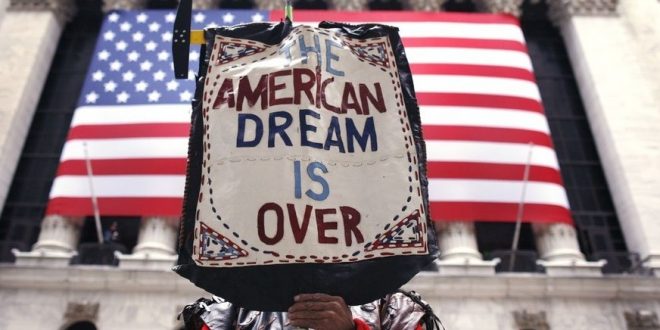Alwaght– Over the past few years, there has been a debate at the global research centers and media about the US power decline and the change of the world order from unipolar to multipolar. How serious is this decline? What are its signals? And what outcomes could it bring about?
The American hegemony
When George H. W. Bush became the president of the US, two years later he witnessed in 1991 the fall of the Soviet Union. This situation pushed the American leader, the strategists, and political analysts to declare the end of the bipolar global order which was a legacy of the Second World War. After the collapse of the Soviet Union, Bush announced the birth of the age of the utter US hegemony and the start of the “American century”, saying that the nations from that time on will live in a world dominated by the American lifestyle, values, and culture.
His son President George W. Bush also continued what the father started, though in another way. He built his agenda on the Francis Fukuyama’s “end of the history” and Samuel P. Huntington’s “clash of the civilizations” theories. Then he announced the organized terrorism as the new US enemy after the Soviet Union and invaded Iraq and Afghanistan amid claims that the two countries were its bastions.
However, it did not take a long time before the rise of other signs conflicting the hegemony theory. Noam Chomsky, an American theorist, argued that the US power demise had started after the WWII and that the US leaders’ boasting of their country being the unchallenged power since 1991 was simply “self-delusion.”
Termite decline
There is a distinction between decline and collapse of course. The decline is the prelude to the collapse and has less tangible signs. The superpower has all the ostensible signs of being a power and invincible, even more than before. However, its economic and political structures grow weaker and weaker. The termite decline concept was first suggested by Ted Galen Carpenter, a professor at the CATO Institute which is an American think tank headquartered in Washington D.C. Then it was used in 2018 in an article by Christopher Layne titled The US-Chinese Power Shift and the end of Pax Americana, which was dedicated to prove the US decline as a superpower. In the article, he claims that the recession of 2007 and 2008, in fact, did not end.
He added that the US decline has started from the economic area and is advancing slowly. Pax Americana is a term referring to the US leadership over a large area of the world covering Europe to Turkey, a large part of East Asia, Latin America, and West Asia. As other powers, like China, rise to prominence, the US power loss moves faster. This collapse takes place in four areas: economic power, military power, soft power, and institutional power. Washington needs to save its strategic hegemony in three regions of Europe, East Asia, and West Asia. But with the rise of China as an economic, and military, power the US hegemony in East Asia is largely challenged. The East Asia affairs researcher Roger Cliff of Rand Corporation, a think tank whose analyses are widely used by the Republican leaders for policy making, in his book The Military Potential of China’s Commercial Technology wrote that by 2020 China’s military will be equal to the US’s. He predicted that by 2020, the US military superiority in East Asia will considerably scale down to China’s favor.
Signs of decline
Henry Kissinger, the prominent US politician, in a comment on the President Donald Trump policy says “I think Trump may be one of those figures in history who appears from time to time to mark the end of an era and to force it to give up its old pretenses.” Trump, a man of wealthy American class, paradoxically names himself the voice of the lower classes, mainly the blue collars who have smaller political participation compared to the others. Derek Thompson defines the Trump supporters as racist and xenophobic. Thompson says they are marked by anger. An American expert in an analysis calls this situation change of global order from the right and left alliances to horizontal alliances of the proletariat class against the global elites like the multinational companies. This, he suggests, leads to a shift from international institutions’ dominance to the bilateral agreements that challenge the unipolar order.
The US had $7 trillion of debt at the end of the Iraq and Afghanistan war. According to the Federal Reserve prediction, the US national debt will be close to $24 trillion by 2020. Although with $20.5 trillion GDP the US economy in 2018 accounted for 24 percent of the global economy volume, the World Monetary Fund in its report, published in late 2018, said that the Chinese economy will unseat its American rival in 2021 with over $23 trillion of GDP. The US share in the global economy will move back to below 20 percent in the next two years.
Now, according to the purchasing power parity factor, China with $27 trillion ranks first, followed by the US with $20 trillion. When it comes to the soft power, which is one of the pillars of the US global leadership, Washington has been in a decline since 2016, ranking fourth now globally from top power. With the Trump policies, this fall even goes faster in the upcoming years. Up to 2018, the US was the most competitive economy with great benefits to investment and business. But a latest report issued by the IMD business school shows that in 2019 Washington lost the title as the most competitive economy to rank third globally.
Trump in his national security document, published in 2017, admits to the US power erosion and seeks American exceptionalism to reverse it. The use of this strategy is itself a sign of the US decline as Trump seeks to impose on the world the radical aspect of the American identity in a bid to halt the collapse. The US president also embarked on a policy of neo-isolationism to delay the power downturn. To cut the commitment and the costs of being a party to the international agreements and institutions, like the Paris climate agreement, UNESCO, and Trans-Pacific Pact (TPP), Trump pulled out of them. The measure only considerably reduced US global leadership and influence. At best, by 2030 in a multipolar world, the US will be an ordinary power among others with a reduced toehold in the world’s strategic spots.
 WILAYAH NEWS VOICE OF THE GLOBAL AWAKENING
WILAYAH NEWS VOICE OF THE GLOBAL AWAKENING






